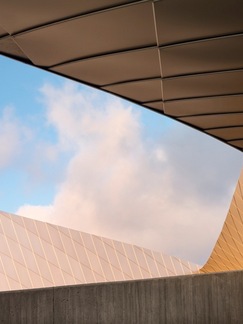-


Copenhagen aquarium "The Blue Planet"
Inspired “by the shape of water in endless motion”, Denmark’s new national aquarium, the Blue Planet, is northern Europe’s largest and most modern.
The whirlpool concept on which this unusual edifice originates is, according to Copenhagen-based architectural practice 3XN: “in a narrative about water, and as an image, is at once both abstract and figurative”. The practice also cites shoals of fish and swirling starlings for influencing the vortex-like form of the building.
Images courtesy of Adam Mõrk
Architect Architects 3XN Location Copenhagen - Denmark Company involved Novelis Website http://www.novelis.com
“Our wish was to bring our visitors all the way down to the world of the fish,” explains 3XN partner and creative director Kim Herforth Nielsen, and the design is based “on the story about water and life under the sea”.
The appearance of this astonishing building which sits as having just emerged from the ocean depths, changes dramatically in response to both daylight and the weather conditions, as well as the position and proximity of the viewer. From the front, its rounded, organic profile evokes silvery-grey waves, while close up the shimmering metal-coated facade resembles fish scales. Visible to airline passengers arriving and taking off from nearby Copenhagen Airport, it looks from the air like a giant white starfish.
The whirlpool concept was chosen not only for its visual associations, says 3XN, but also because it resolved a practical challenge in the design brief - as one or more of the building’s “arms” can be extended easily when more exhibition space is required, “without disrupting the building’s integrity, nor the operation of the aquarium”.
From its circular, central foyer visitors can choose which river, lake or ocean to explore. Multiple routes reduce queues in front of individual aquariums and the interior includes both grand and intimate spaces.
The Blue Planet occupies an elevated headland north of Kastrup Harbor. Founded on piles, it extends beyond the original coastline. A service line, built 1.7km out into the Øresund, provides water for the aquaria and for the building water cooling system and climate control systems.
The facility is dedicated to nature conservation, as well as raising awareness of issues relating to water. It was designed to be sustainable and self-sufficient, and its staff work with researchers and scientists to help reduce over-fishing, pollution and other threats to endangered marine species.
Exhibitions include coral reefs, the ocean, Africa’s lakes and the Amazon. Water inside the aquarium is filtered and recycled in a closed-loop system, while seawater is used to keep the entire facility cool. One of the arms, featuring indoor gardens, is naturally lit from above via vast skylights.
As the only aquarium in Denmark, the Blue Planet focuses on all aquatic life – from cold and warm waters, fresh and saltwater. It contains approximately seven million litres of water in 53 aquaria and displays. It is home to 450 different species and 20,000 fish and other aquatic animals, including sharks, dwarf crocodiles, moray eels and barracudas. The largest residents are the hammerhead sharks, which measure between three and four metres long.
Visitors can get close to the life both below and above the water, in a humid rainforest, for example, or on a Faroese cliff. Outdoors facilities include a terrace with seating, a pond with carps and a tank with sea lions, which can also be viewed from inside of the building.
3D-modelling played a major part in designing the aquarium’s concrete and steel sub-structure, a complex load-bearing system comprising 54 unique steel frames with radial positioning and geometry forming the base of the curved facades.
The building’s 1.2mm-thick facade, supplied by Novelis, comprises approximately 27,000m² of coil-coated aluminium, processed into 40,000 identical diamond-shaped shingles. Protected with a coat of clear lacquer, these are fixed on to a substructure of omega profiles.
“For 600 million DKK (US$107.6 million) we have been able to construct a unique building, where architecture and technical demands have challenged our fantasy and abilities to the extreme,” said Bent Frank, chairman of the Blue Planet Building fund.
Images courtesy of Adam Mõrk
































